Charming Leipzig is Central Germany’s biggest city and a wonderful place to check out for first time visitors to the country. It’s arguably the cultural capital of the region and packs tons of historical sights but at the same time doesn’t draw the amount of tourists other big German cities like Berlin, Munich or Hamburg do.
For history buffs and fans of architecture alike, one of the main reasons to visit Leipzig is checking out its gargantuan Völkerschlachtdenkmal – the Monument to the Battle of the Nations or Völki as the locals affectionately call it. Check out everything you need to know about visiting Europe’s biggest monument in this guide.

This post may contain affiliate links and I might earn a small commission at no additional cost to you. For more info click here.
What does the Monument to the Battle of the Nations commemorate?
The Monument was erected in commemoration of the defeat of Napoleon’s French troops during the namesake battle in October 1813, one of the most decisive fights during the Wars of Liberation fought against the French hegemony in Europe.
During the battle, which took place over four days and led to the death of almost 90,000 people, a coalition of Austrian, Prussian, Russian and Swedish Troops fought against the French who were supported by the local Saxons in one of their more unwise political decisions.
One of the most devastating battles before the first World War, fighting took place all over the city and its surroundings, but the heaviest clashes happened on a plain where the monument now stands. The Völkerschlachtdenkmal itself was erected in 1913 for the centennial of the battle and was hailed both for its humongous size and the necessary achievement in structural engineering.
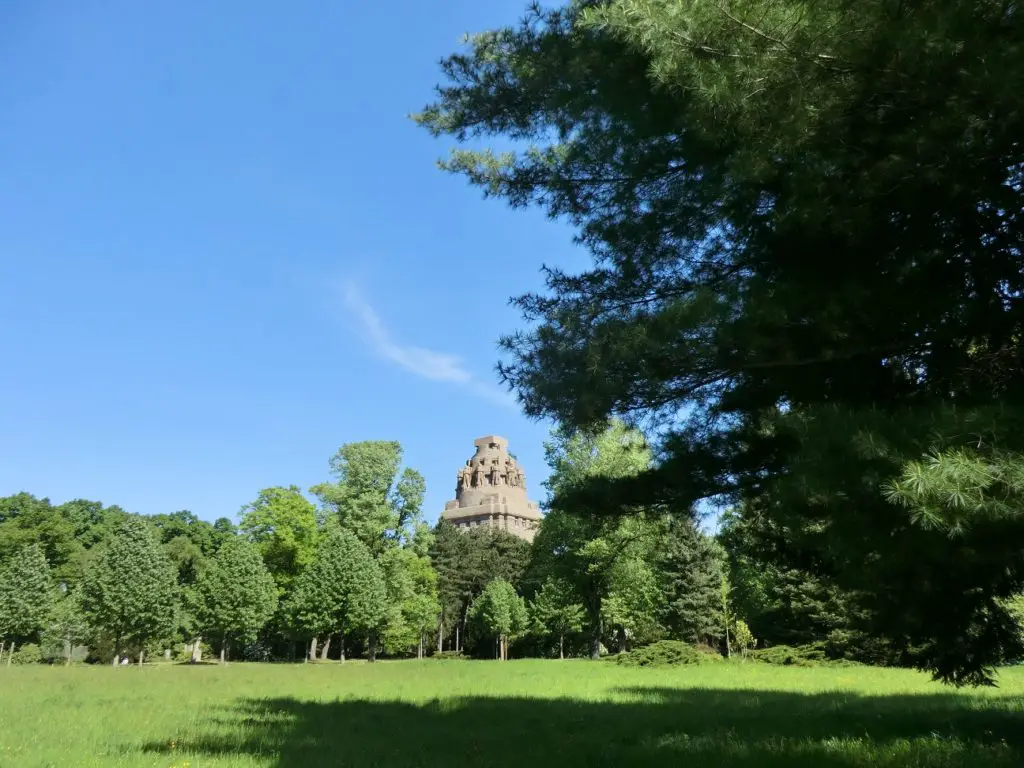
Standing 91m or 300ft. tall, the building is to this day the biggest monument in Europe and the view across the reflecting pool carrying the somewhat dramatic name See der Tränen (Translating to “Lake of Tears”) is quite impressive.
If the thought of visiting an enormous chunk of concrete and granite commemorating the death of tens of thousands of people doesn’t appeal to you (which I get;-), be ensured that climbing to the top of the structure affords wonderful views of Leipzig and its surrounding countryside.
When to visit the Monument to the Battle of the Nations
As you might expect, from the outside the monument is open 24/7, but if you want to visit the interior and climb to the viewing platform, you’ll have to come between 10am and 6pm from April to October and between 10am and 4pm from November to March. Every Thursday at 2 p.m. there are guided tours.
The imagery of the Monument
The entire imagery on the outside and interior of the monument is inspired by the growing sense of German Nationalism during the first half of the 20th century and even if the erection of the monument predates the rise of fascism, the imagery, combined with the all-encompassing monumentality and the symbolism of the structure clearly hints at what Germany was to become later on.
As such, visiting the Völkerschlachtdenkmal is at once imposing and eerie, and you’ll be excused if your sense of awe is somewhat tempered by a feeling of uneasiness. I certainly feel that way every time I visit the monument.
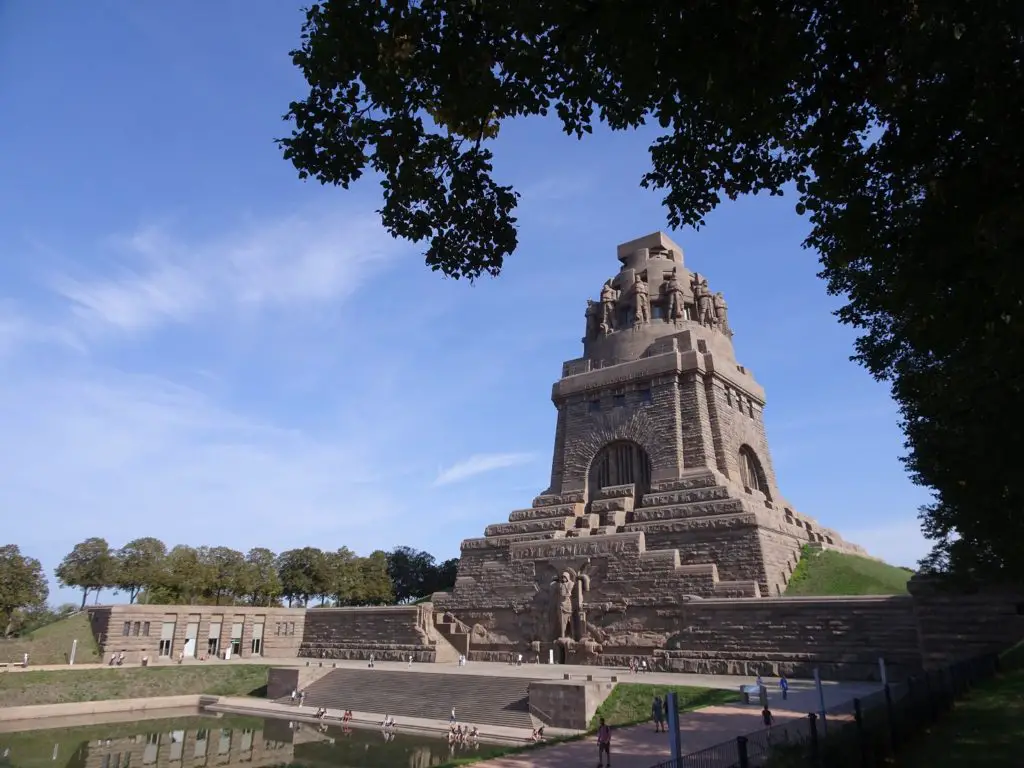
The giant figure on the front façade depicts the Archangel Michael, which looks more like a personification of vengeance than anyone leading souls to heaven. In fact, the words “Gott mit uns” inscribed above his head translate to “God with us” serving as a divine legitimization of the German victory.
The Archangel is framed on both sides by reliefs depicting the furies (Goddesses of Vengeance) of Ancient Greek Mythology. Twelve statues of warriors in the higher section of the monument stand guard and are supposed to represent the willingness of the people to defend themselves, while bearded faces along the stairways depict 12th century German Emperor Barbarossa.
What to see inside the Monument
When visiting the interior of the monument, there are basically three main areas of interest: The crypt, the so-called “Hall of Glory” (Ger. Ruhmeshalle), and the two viewing platforms.
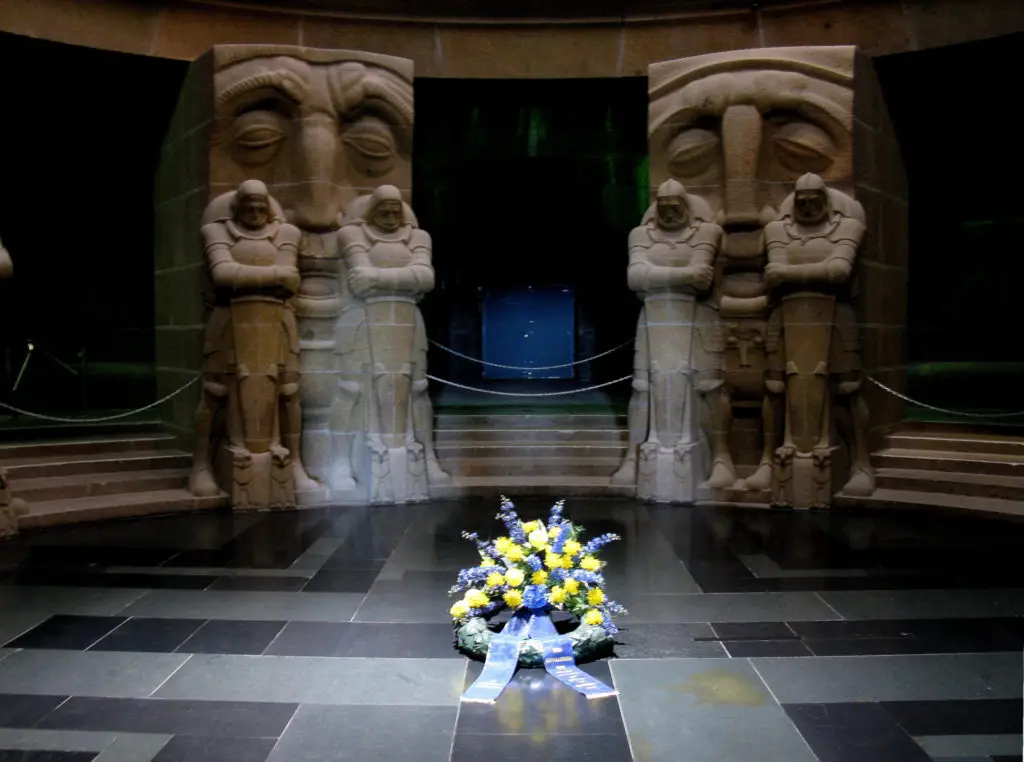
The entrance to the crypt at ground level is located beneath the feet of the Archangel Michael statue. The room serves as a memorial to everyone who died during the battle. Along the walls, pairs of stone warriors stand guard, leaning on their high shields, lending an ominous air to the tranquillity of the place.
The so-called Hall of Glory can be reached by ascending the outer staircase of the monument. Inside, the impressive cupola is decorated with friezes depicting a total of 324 nearly life-sized riders. Four gigantic statues are meant to personify traditional values (bravery, strength of faith, people’s strength, and sacrifice).
Again, the figures are full of pathos, the ominous poses already foreshadowing the self-glorifying statuary of the Third Reich.
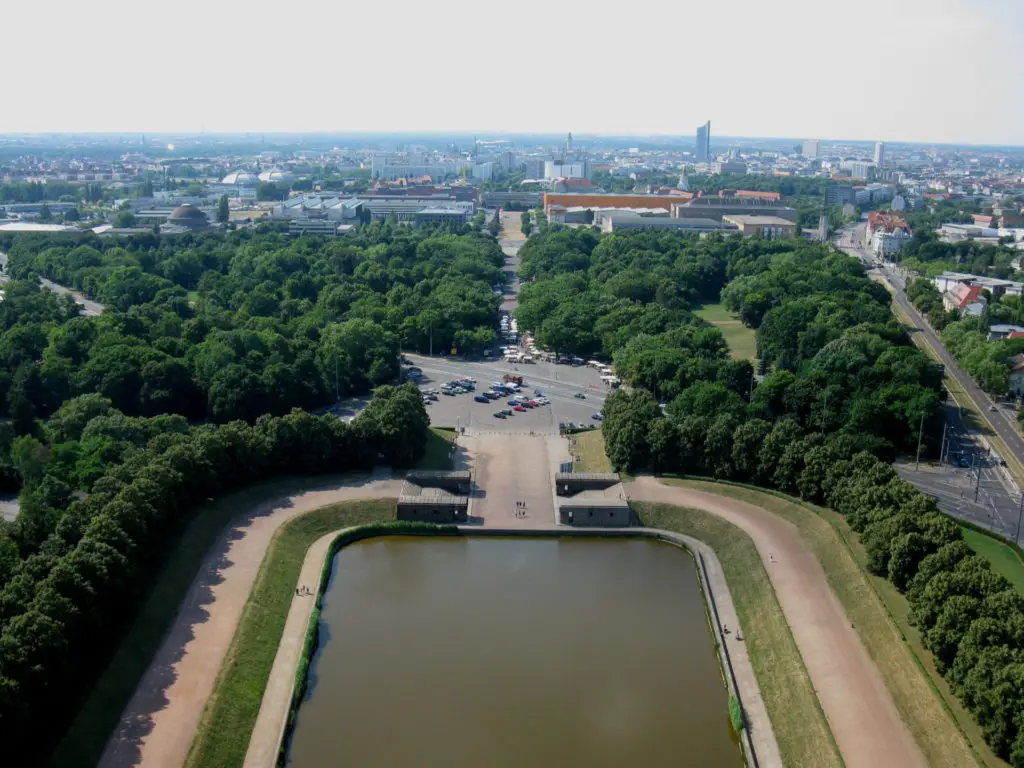
Use the stairways in the interior to leave all this heavy symbolism behind you and reach the balcony that runs once around the monument as well as the viewing platform atop the structure, which affords even better views in all directions.
To the north-west is the skyline of central Leipzig, while the imposing building to the south-west, which some visitors take for a castle, is actually the chapel and crematory of the “Südfriedhof”-cemetery. Monumentalism didn’t stop at monuments back then, I guess…
Forum 1813 Museum
This small but informative museum is located right next to the monument and is included in the entrance fee. It details both the events during the Battle of the Nations and the circumstances leading up to it, and the general political climate of Europe during that time.
There’s a big detailed diorama of the battle as well as several objects retrieved from the area afterwards, including personal belongings of Napoleon. It’s to your right when you’re facing the monument.
Other sights in the area
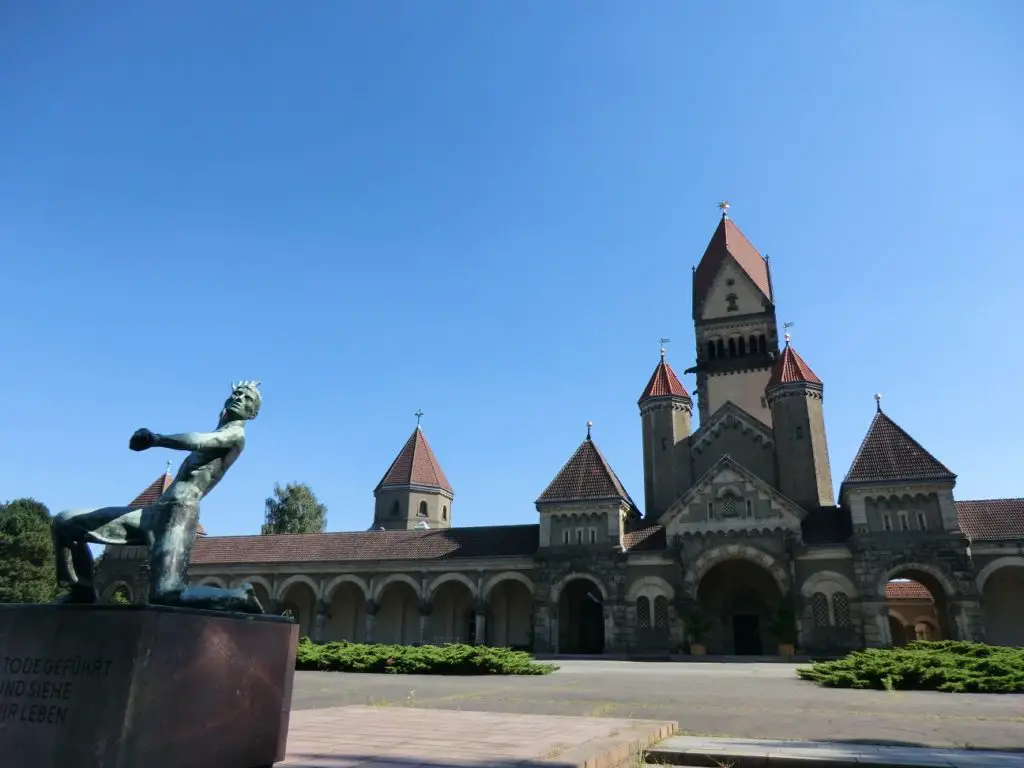
There are several other low-key attractions in the direct vicinity, including the Napoleonstein, a small monument erected at the spot where Napoleon is supposed to have commanded his troops from. It’s rather plain, only depicting the emperor’s distinct triangular hat atop a pedestal.
The nearby Marienquelle formerly served as a source of drinking water to the area. Rumour has it that the water had healing properties, and it was considered important enough that the entire surrounding borough of the city (Marienbrunn) is named after it. Both of these can be found in the small park to the west of the reflecting pool in front of the monument.
South of the park, Südfriedhof, Leipzig’s biggest cemetery contains not only the graves of some famous people connected to the history of the city (incl. artist Werner Tübke) but also the biggest cemetery chapel in Germany, which was based on the medieval monastery Maria Laach in the Eiffel Mountains.
How to get to Leipzig and the Monument
As one of the biggest cities in Central Germany, there’s no shortage of trains running to Leipzig, for example from Berlin Central Station (about 1h 15 min / 35 €). It’s easiest to check the connections on the website of the German train network. A cheaper, if somewhat slower, option is using the good long-distance bus network of Flixbus.
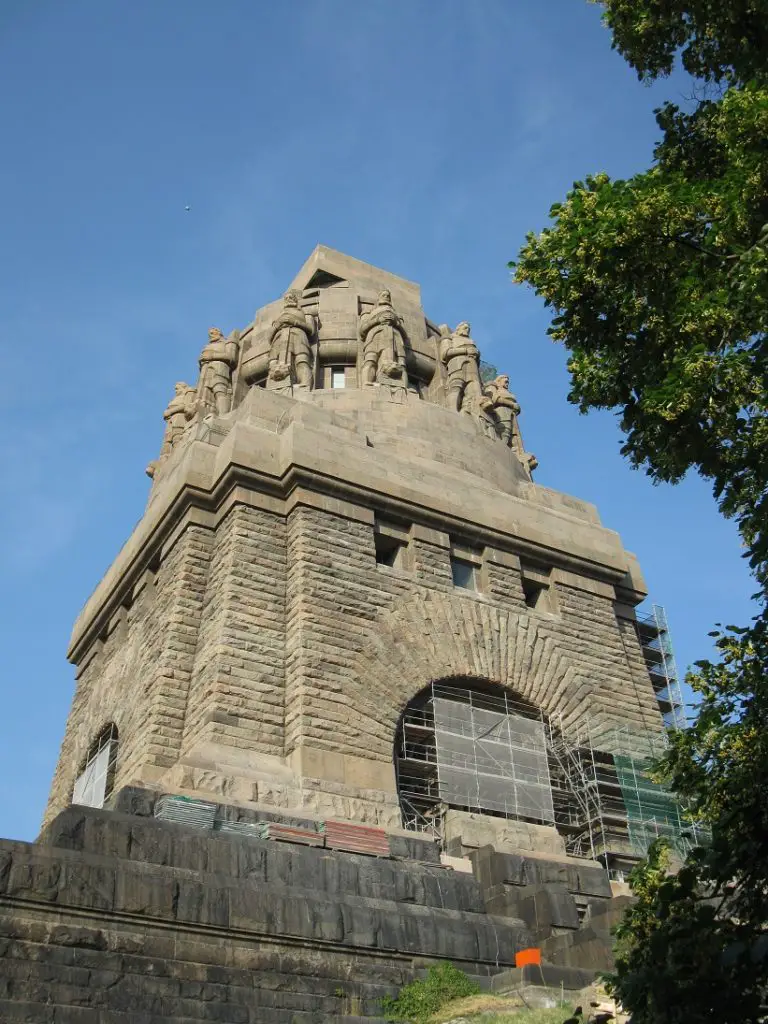
Once you’re in Leipzig, getting to the monument, which is located south-east of the centre, is rather straightforward. The fastest way is to take the regional train (S-Bahn) from the main station or the market in central Leipzig to the aptly named station “Leipzig Völkerschlachtdenkmal” (about 10 mins / 3€).
Alternatively, tram lines 2 and 15 and bus 70 also pass by the monument. You can check out the public transport map for all of Leipzig here.
How much does it cost to visit the monument?
Entrance to the monument, including the nearby Forum 1813 Museum is 10€.
Where to stay in Leipzig
You can check out my guide to the best Hotels, Hostels and Guesthouses in Leipzig.
As you would expect, most accommodation options can be found in central Leipzig, and close to the train station, including several cheap hostels for the budget-minded, like Hostel Sleepy Lion or Five Elements Hostel. Hotels in the direct vicinity of the monument are more in the mid-range section. You can browse for nearby accommodation in this map:
Where to eat near the Monument
There are surprisingly few restaurants in the direct vicinity of the monument, the closest being Pellorus, directly across the road to the northern end of the reflecting pool. There’s also a small café called Bistro 1813 at the northwestern corner of the pool.
What else to do in Leipzig
The ultimate one-day itinerary for Leipzig
The best Hotels, Hostels and Guesthouses in Leipzig
Visiting nearby Colditz Castle, the famous WW2 POW Camp
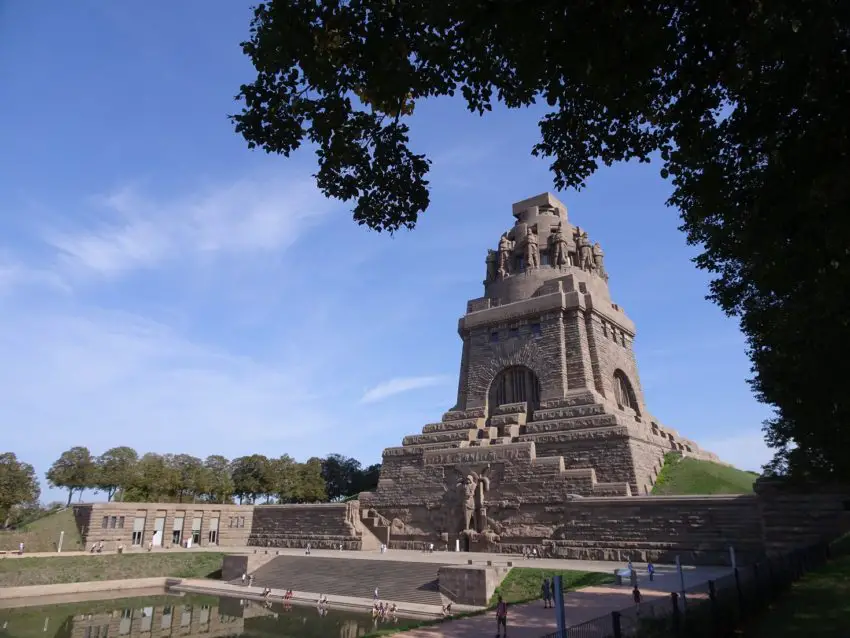
1 thought on “Visiting the Monument to the Battle of the Nations or Völkerschlachtdenkmal in Leipzig, Germany”